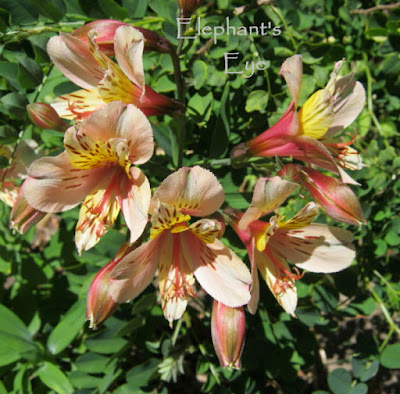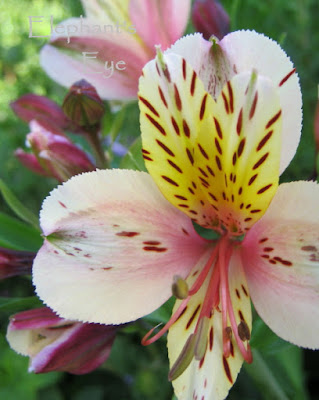Alstroemeria Inca lilies
by Diana Studer
- gardening for biodiversity
in Cape Town, South Africa
I first saw Alstroemeria - what are those flowers - in my father's wreath 25
years ago. Delicately beautiful lilies, petals intricately patterned, and an
unknown flower made a fresh and lasting impression.
Since I prefer to use indigenous
plants in my garden, it was never something I chose for our garden. Fast
forward to the False Bay garden where I am working my way thru removing the
unwanted plants among those I inherited. Inca lilies, exotic, are out. But
wait. When we moved here in November 2014 it was the Inca
lilies that gave me a vase for our new home.
Between sun and shade, cell phone
and camera, the colour changes, but mine are a salmony flesh-eating pink -
which I am learning to accept, if not exactly like.
The original clump was behind the
lemon
tree, where I am working towards blue (or purple) and white flowers for
Cornish Stripe. I yanked out everything I could get at and looked for a
generous space to move them to. One of the new raised beds needed filling.
Again fast forward. I have a
gazillion long stalks, the first few flowers, the second round of buds coming,
and almost every green stalk will bear a flower. An embarrassment of Inca
lilies. I see great bunches in my future!
I prefer plants which are, if
exotic, at least from our mediterranean climate and waterwise. Where, I now
realise, the Inca lilies fit into South American Chile, a companion to my lemon
verbena. Quite dormant and invisible in summer, they emerge with the rain,
and bloom for months. Years before I had Alstroemeria, I read that one should
gently tug out from the base faded bloom stalks.
Recently I found detailed maps
from the Pacific Bulb Society of the range of mediterranean climates
worldwide. Including an Asian bit which doesn't appear on my sidebar map. From
there come tulips and fritillaries (in deserts which are very cold, then dry in
summer). Our huge diversity of endemic bulbs means that South Africa's Cape
Floral Kingdom splits up into varied climate zones. A whole new layer of
information for me to work thru.
From wet in Hout
Bay (once were forests) to Cape Town and Stellenbosch.
Hopefield, Caledon and Ceres merely damp. Clanwilliam
is dry. Saldanha, Worcester (succulent
botanical garden) and are moderate desert. Port Nolloth, Vanrhynsdorp and
Springbok (Namaqualand)
are extreme desert.
We have a friendly temperate
climate in Cape Town (Kirstenbosch),
Hout Bay, Hopefield, Clanwilliam, Saldanha
and Port Nolloth. Cool in Stellenbosch, Caledon (near
the apple orchards), Worcester and Vanrhynsdorp. Finally cold Ceres
(snow and cherry orchards), Nieuwoudtville (Hantam
botanical garden) and Springbok. Frigid is off the chart for South Africa.
Cape Town slots in with Perth and
Lisbon on that Pacific
Bulb Society chart.
Alstroemeria grows
from a rhizome. I may be haunted by persistent plants from 'where I dug them all
UP'. Mine has very long stems making them versatile in the vase. My sixth
choice among Discovered Treasures follows the Septemberbossie.
Only on the computer do I see that the petals are very finely serrated!
Joining me in my Dozen for Diana is Pam from the Pocono Mountains in Pennsylvania with her anise hyssop.
Battling to spell Alstroemeria but Wikipedia tells me - 'the genus was named after the Swedish baron Clas Alströmer (1736 – 1794) by his close friend Carl Linnaeus'. Swedish, no wonder I can't spell it.
I invite you to join us at Elephant's Eye on False Bay.
Please subscribe as you prefer
via Feedly,
or Bloglovin,
or Facebook
(If you mouse over teal blue text, it turns seaweed red.
Those are my links.
To read or leave comments, either click the word Comments
below,
or click this post's title. If you are in email or a Reader,
first click thru to the blog)










I'm very fond of Alstroemeria, although the varieties I inherited with the garden aren't the tall, evergreen type I favored in my old garden. Mine are runts that die back at the end of spring and don't return until the following year. I'm still on the look-out for the tall variety I foolishly left behind when we moved here.
ReplyDeleteThis one does die back - for which I'm grateful, as it is currently a HUGE billow of green, overwhelming the small trees that were planted there first.
DeleteAlas, my climate is too cold to overwinter these beauties, but they're wonderful cut flowers! Your arrangements probably last for more than a week, right? When I first discovered these flowers, I wasn't a big fan. But in recent years we've been seeing fuller, healthier Alstroemerias--available at florists and markets for cut flowers. Now I like them! They look beautiful along your paths and mixed in with other flowers in your arrangements!
ReplyDeleteBecause the head is a cluster of flowers, they seem to last for ever. And I change the suporting cast.
DeleteDon't be too harsh on the Inca lily, I think it looks fresh and cheerful in the photo, and nice against the green in the garden. Very interesting Cape Town matches Perth on the bulb chart. Western Australia is famous (here) for its wild flowers, as with the Cape. (although not bulbs of course.
ReplyDeleteOf the bulbs that site shows for Australia, the only one I recognise is Anigozanthos from flower club days.
DeleteThey are beautiful, I'm so glad you kept them. I just have 2 varieties, one tall and one much smaller, both lovely.
ReplyDeleteI'm glad you decided to make a space for the Alstroemeria; I love them as cut flowers as they last so long in a vase. I have one plant that is flowering again now we've had rain but its stems are very short; your description of it as a Mediterranean climate rhizome has encouraged me to look for some long stemmed varieties. Thank you.
ReplyDeleteFrom my wide experience of one plant, I only discovered short stemmed ones as this month's recommendation from our wholesale nurseries. Offered as a pot plant choice by them.
ReplyDeleteI like them too. I have a clump of them similar in colour to yours. It struggles a bit in our wet climate but still manages a few new stems every year. A huge billow of green is aspirational for me!
ReplyDeleteI envy you Diana. For your wonderful climate and for the fact that everything seems to thrive in your garden. I am always struggling to keep my plants alive.
ReplyDeleteand I wish that you could show me how to prune my Japanese maple.
DeleteYour garden always looks so green and serene!
They are real beauties! Know why you're falling in love with them. The more I read your lines about South Africa the more I go for a visit soon.
ReplyDeleteAll my best and thank you
Elisabeth
The Alstroemerias in your garden are gorgeous. I once planted similar ones in my own garden, but they did not prove quite winter hardy. I think I may try again and give them better winter protection, as I truly do love them. Your November 2015 bouquet is wonderful.
ReplyDeleteI wasn't too keen when I saw Alstroemeria in bouquets here, but you won me over. I envy your temperate climate -- I can't grow them. P. x
ReplyDelete(Sometimes I yearn for a little break from But I Pruned That Last Week ish ;~)
Delete